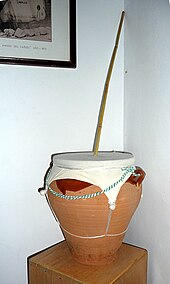Grating drum
The friction drum , also known as the friction drum , is a musical instrument belonging to the membranophone class . In contrast to beating drums , when playing the friction drums, the skin is not vibrated by striking it, but by friction, which can produce rather elongated rustling, humming or squeaking sounds. Its main distribution is in Latin America, Europe, Africa and China.
Classification
The Hornbostel-Sachs system distinguishes three subclasses of friction drums:
Rod rubbing drums : The skin is played with a rod. Usually, the rod is placed lightly on the center of a membrane stretched over a hollow body. If you stroke up and down the rod with wet fingers, the vibrations generated in the rod are transferred to the membrane and cause a humming sound. The rod grater drums include:
- the northern european humming pot ,
- the Brazilian cuíca ,
- the rare ingungu , which the Zulu used to play in South Africa and consists of a goat skin stretched over a clay pot,
- the Zambian namalwa ( ChiTonga , "lion drum "),
- the southern Italian putipù , also caccavella, cupa cupa and other regional, sometimes onomatopoeic names,
- the puita in the Congo with an approximately 50 centimeter long, cylindrical body and a rod made from a palm leaf rib,
- the spanish zambomba .
Cord rubbing drums : The skin is played with a cord. The cord grating drums include:
- the ukrainian buhaj ( ukrainian : бугай ),
- the Czech fanfrom with a tuft of horse hair,
- the Chinese ha-ma with a single horsehair,
- the Turkish chaplain kabağı with the body of a calabash ,
- the forest devil , who is also counted among the swing drums: the cord knotted with the membrane is connected to a rod and the drum is moved around freely.
Hand rubbing drums : The skin is rubbed by hand.
At the lower end, the rod is firmly tied to a bulge in the eardrum. A notch on the rod prevents the cord wrap from slipping off. With the cord rubbing drum, the cord is knotted in the middle of the skin.
In contrast to the Hornbostel-Sachs system, Bigamudre Chaitanya Deva, in his classification of Indian musical instruments, limits the group of rubbing drums to those drums whose membrane is rubbed directly with the hand or an object. In the Indian states of Andhra Pradesh and Karnataka, these include the burburi , a double-headed cylinder drum that is played by wandering begging musicians who worship the goddess Mariyamman , and the urumi hourglass drum ( similar to the timila ) from Tamil Nadu . Both drums hang on a ribbon around the neck of the standing musician, who strikes one membrane with a stick and rubs the other membrane with the tip of a curved stick.
Similarly, when playing the drums with a jazz broom, the drums are sometimes not only struck, but also rubbed.
See also
- Ektara , Indian plucking drum
literature
- Henry Balfour: The Friction-Drum. In: The Journal of the Royal Anthropological Institute of Great Britain and Ireland, Vol. 37, January-June 1907, pp. 67-92
- James Blades: Friction Drum. In: Stanley Sadie (Ed.): The New Grove Dictionary of Musical Instruments . Volume 1. Macmillan Press, London 1984, pp. 797f
- James Blades, James Holland: String drum. In: Grove Music Online, 2001
Web links
- John A. Donahue: Applying Experimental Archeology to Ethnomusicology: Recreating an Ancient Maya Friction Drum through Various Lines of Evidence. mayavase.com
Individual evidence
- ^ Percival R. Kirby : The Musical Instruments of the Native Races of South Africa. (1934) 2nd edition: Witwatersrand University Press, Johannesburg 1965, pp. 26-28
- ↑ “Muzemu”. Balizi ba Milopa. Smithsonian Folkways Records
- ↑ http://news.liga.net/news/N0750572.html
- ^ B. Chaitanya Deva: Musical Instruments of India. Their History and Development. KLM Private Limited, Calcutta 1978, p. 98

